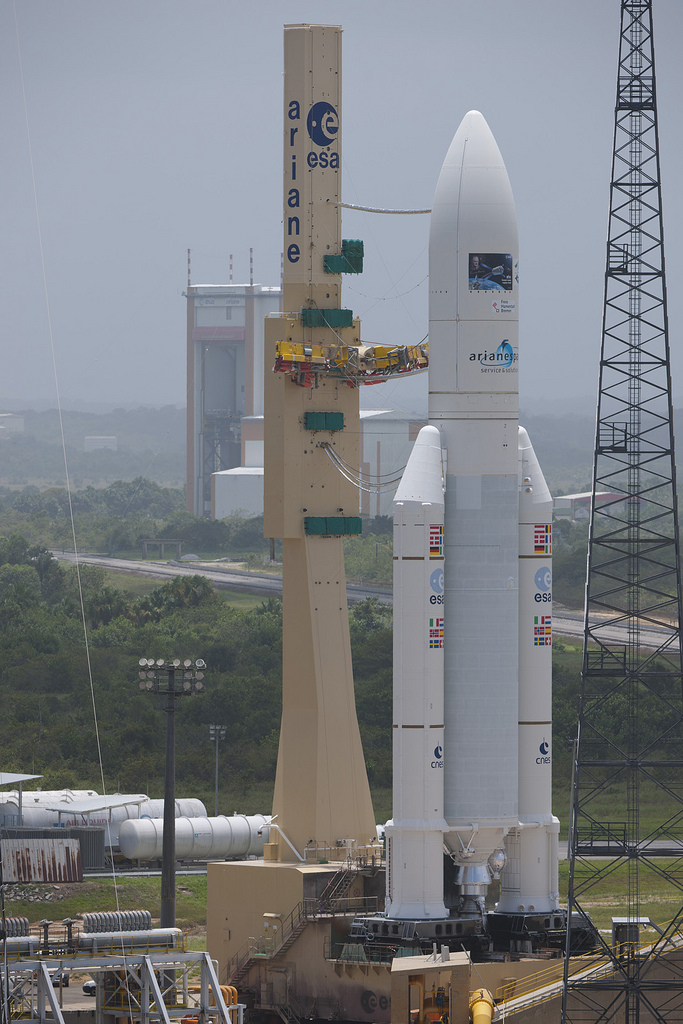Europe Launching Heaviest Space Station Cargo Ship Friday

Watch the launch live via NASA TV here: http://www.nasa.gov/multimedia/nasatv/media_flash.html
A huge, unmanned European cargo ship will launch to the International Space Station in the wee hours of Friday (March 23) on a mission to deliver a load of food and supplies to the orbiting outpost.
The European Space Agency's Automated Transfer Vehicle 3 (ATV-3) is scheduled to lift off from a launch pad in South America at 12:34 a.m. EDT (0434 GMT) on Friday. The spacecraft will launch atop Europe's workhorse Ariane 5 rocket from the Guiana Space Center in Kourou, French Guiana.
The 20-ton cargo freighter, which is nicknamed "Edoardo Amaldi" after the Italian physicist and spaceflight pioneer, is slated to arrive at the space station on March 28. It is the heaviest load of cargo ever delivered to the station by a robotic spacecraft, ESA officials said.
A minor packing glitch earlier this month prevented ESA from launching the mission on its original flight date of March 9. During a pre-flight inspection, officials found two cargo bags that were not properly strapped into place, which required the spacecraft's hatch to be re-opened so the contents could be secured.
Big space delivery
The European ATV vehicles are the largest and heaviest cargo vessels hauling supplies to the International Space Station, according to ESA officials. [Photos: Europe's Robot Space Cargo Ships]
Get the Space.com Newsletter
Breaking space news, the latest updates on rocket launches, skywatching events and more!
The cylindrical spacecraft is 35 feet (10.7 meters) long and 14.7 feet (4.5 meters) wide. In fact, an ATV is large enough to fit a double-decker bus inside.
The ATV-3 Edoardo Amaldi is packed to the brim with more than 6 tons of supplies, including food, water, clothing, experiments and fuel for the space station. The spacecraft is also carrying memorabilia to honor the physicist who inspired its name, ESA officials said in a video. These keepsakes include a letter that Amaldi wrote to a colleague in the late 1950s.
Some of the fuel being delivered to the space station will be used to boost the space station higher in its orbit so that it continues to fly roughly 240 miles (386 kilometers) above Earth.

Robot spaceships fleet
The European ATV vehicles are disposable spacecraft designed to automatically dock to the Zvezda module on the Russian segment of the space station. The cargo ships remain attached to the outpost for up to six months before they are packed with garbage and deliberately sent to burn up during re-entry through Earth's atmosphere.
The ATVs are part of an international fleet of disposable robot cargo ships that are used to carry hardware and supplies to the space station. Russia's robotic Progress ships and Japan's H-2 Transfer Vehicles (HTVs) also regularly make trips to the orbiting complex.
ESA routinely names the ATV vehicles after historical figures that were influential to astronomy or space exploration. The agency's first ATV, named Jules Verne, made its maiden voyage to the space station in 2008. The ATV-2, dubbed Johannes Kepler, launched in 2011.
The next two planned ATVs, named ATV-4 Albert Einstein and ATV-5 Georges Lemaître, are scheduled to launch to the International Space Station in 2013 and 2014, respectively.
You can follow SPACE.com staff writer Denise Chow on Twitter @denisechow. Follow SPACE.com for the latest in space science and exploration news on Twitter @Spacedotcom and on Facebook.
Join our Space Forums to keep talking space on the latest missions, night sky and more! And if you have a news tip, correction or comment, let us know at: community@space.com.

Denise Chow is a former Space.com staff writer who then worked as assistant managing editor at Live Science before moving to NBC News as a science reporter, where she focuses on general science and climate change. She spent two years with Space.com, writing about rocket launches and covering NASA's final three space shuttle missions, before joining the Live Science team in 2013. A Canadian transplant, Denise has a bachelor's degree from the University of Toronto, and a master's degree in journalism from New York University. At NBC News, Denise covers general science and climate change.









